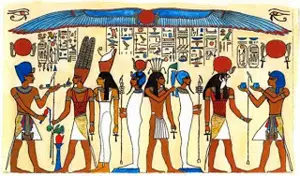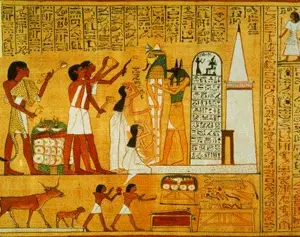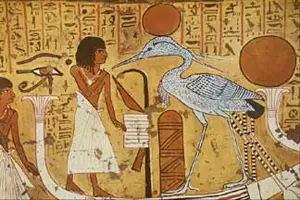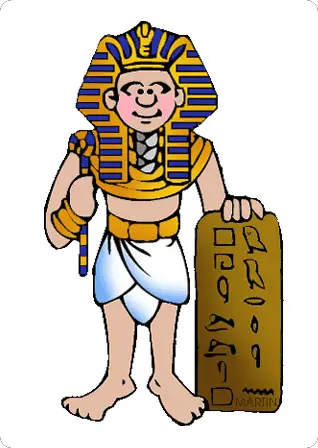Egyptian Painting
Egyptian art paintings were created to serve a variety of purposes, including religious, political, and funerary. They were often highly stylized and symbolic, depicting gods, pharaohs, and scenes from everyday life.
The use of hieroglyphics and the strict adherence to artistic conventions allowed for continuity and consistency throughout the centuries. Egyptian art paintings continue to fascinate and inspire artists and art lovers alike.

Egyptian Art Paintings Facts for Kids
- Egyptian art is over 5,000 years old.
- It often shows people sideways, not front-facing.
- Art was used to tell stories of their gods.
- Wall paintings are found in tombs and temples.
- Colors were symbolic, like gold for gods.
- Pharaohs were painted larger than others.
- They used a grid to keep the proportions right.
- Animals were common in Egyptian art.
- Many paintings depicted everyday life.
- They believed art ensured life after death.
Purpose of Egyptian Art: Ritualistic and Spiritual
Ancient Egyptian paintings primarily served spiritual and ritualistic purposes. Many artworks adorned tomb interiors, ensuring a smooth passage into the afterlife. Paintings often depicted the deceased interacting with deities, immortalizing their deeds and showcasing close divine ties. Thus, art in ancient Egypt became a significant component of religious practices and beliefs, integral to their journey to eternity.
Formal Frontality in Statuary
Formal frontality, where figures face straight ahead, was key in Ancient Egyptian statuary. Not for anatomical accuracy, this style was used for its symbolic emphasis. The statues were often in profile, but their gaze was directed ahead, indicating their role as intermediaries in rituals, bridging the physical and spiritual realms.
Role of Divine, Royal, and Elite Statuary
Divine, royal, and elite statuary played a significant role in Ancient Egyptian art. These statues served as conduits for the spirit, enabling spiritual interaction. They linked the earthly and divine realms, often becoming worship focus in chapels or temples. Their prominence in art reinforced social hierarchies and religious beliefs.
Materials and Naturalism in Statuary
Materials in Ancient Egyptian statuary impacted naturalism. Stone sculptures were rigid but enduring, while wood and metal allowed more dynamic positions and lifelike appearances. Despite the material, all statues aimed to balance naturalistic aspirations with their spiritual purpose.
Hierarchical Representation in Art
Ancient Egyptian art used size and position to convey hierarchy. Larger figures and those higher in scenes were more important. This ‘hierarchy of scale’ provided clear cues about the social order within the artwork.
Two-Dimensional Art and Composite Imagery
Egyptian two-dimensional art embraced composite imagery, showing each object from its most recognizable angle. Despite the visual inconsistency, this provided a comprehensive depiction of the scene elements.
Use of Registers in Scenes
Ancient Egyptian art used registers, dividing paintings into horizontal bands to depict narratives and maintain organization. Registers differentiated events, characters, or landscapes, whether on tomb walls, papyrus scrolls, or temple reliefs. They also imposed a sense of hierarchy, drawing attention to significant moments or figures. This artistic style ensured the art’s longevity and legibility, vividly showcasing ancient Egyptian culture.
Hierarchy of Scale in Art
The hierarchy of scale in ancient Egyptian art emphasized specific figures’ importance by altering their sizes. This technique depicted gods and pharaohs as the largest characters, highlighting their superior status, while smaller proportions reflected subordinate standings. This method conveyed narratives and underlying messages within Egyptian art, expressing power dynamics and social order while ensuring clarity and symbolism for contemporary and future audiences.
Text and Image Interplay in Art
The interplay between text and image in ancient Egyptian art demonstrates their harmonious storytelling approach. Hieroglyphic inscriptions alongside visual portrayals added context to narratives, emphasizing specific figures or events. This integration reflects the importance placed on written language in Egyptian society and facilitated deeper connections with viewers. Ancient Egyptian art paintings stand out for their unique intertwining of visual and textual narratives.
Art in Tombs and Temples
Art in ancient Egyptian tombs and temples immortalized their beliefs, customs, and lifestyles. Tomb paintings showcased the journey to the afterlife while temple art depicted the sacred connection between pharaohs and gods. These elaborate murals and reliefs granted crucial insights into Egyptian spiritual practices and conveyed their sense of grandeur and piety. The craftsmanship of tomb and temple art continues to instill wonder and respect across generations.
Symbolism of Egyptian Tomb Paintings
When archeologists began discovering ancient Egyptian paintings, they were found in tombs and burial places. This is important, as the paintings were never meant to be seen by human eyes after the tombs were closed. The Egyptians painted the walls and ceilings in the belief that the one who had passed would be able to take all of the images of their life with them and only the deceased and the Egyptian gods would ever see the paintings.

Permanence and Formality in Ancient Egyptian Paintings
When you look at ancient Egyptian paintings, they seem very formal as compared to Greek or Roman paintings and art. While the Egyptians ruled for over 3,000 years, their art and painting didn’t change very much.
The tombs of the pharaohs were covered in colorful representations of the one who had passed, living a happy life, with plenty to eat and drink and the weather always perfect. The pharaohs were even shown with all of their slaves around them so that they could serve and care for them in the afterlife.
Techniques and Colors in Ancient Egyptian Art
Egyptian painting was used in a number of ways, including painting directly on the surface. Another method was to create a ‘relief’, which is a raised image above the background, and then carefully paint the details of the image.
There is a second type of relief which was carved out and is referred to as ‘sunk relief’, and the images were painted with a raised background surrounding them.
Although most of the Egyptian statutes that we see today do not show any color, they were originally painted with bright and what we might consider today to be gaudy colors. They believe that even the Sphinx was at one time brightly painted.

Colors and Preservation Techniques in Ancient Egyptian Paintings
The paint that the Egyptians used was colored or dyed using minerals that were naturally found in their area and some that they imported. The favorite colors that were used in painting were: red, blue, green, gold, and black; but they also used white, pink, and gray.
The colors and all of the objects found in tombs were preserved due to the cool dry environment and that’s why we can see them today with such bright tones. Artists would grind the minerals into fine dust and then mix them with a kind of ‘glue’ made from animals or plants. It was important to make just the right mixture because the paint had to not only stick to the walls but was designed to last forever.
Symbolic Significance of Colors in Ancient Egyptian Paintings
Colors were taken very seriously in ancient Egypt and the colors and tones that they chose for each painting were carefully selected. There were differences in skin tone color between men and women. Men had a darker reddish brown to reflect their outdoor life and women had a lighter, almost yellow-brown color to show they lived mostly indoors or in a sheltered location.
Each color that the ancient Egyptians used was also a symbol, many of these we continue to use today.
- Blue represented the sky, water, the heavens, the ancient flood, and both rebirth and creation.
- Red was the color of fire, anger, life, chaos, victory, and hostility.
- Yellow represented eternal, imperishable, indestructible
- Green was the color of vegetation, growth, joy, fertility, new life, and regeneration
- White is the color of cleanliness, power, purity, simplicity

Color Techniques and Symbolism in Ancient Egyptian Paintings
Egyptian artists mixed colors to depict realistic details in paintings. Colors had various shades, depending on their purpose. Gods were painted with specific colors, representing their realm, while royalty was painted with blue and gold, symbolizing strength and power.
What is the most common subject matter in Egyptian art paintings?
he most common subject matter in Egyptian art paintings is the human figure. This includes depictions of both real people, such as the pharaoh and his family, and gods and goddesses. Other common subjects include animals, such as lions, crocodiles, and cats, as well as plants, such as lotus flowers and palm trees. Scenes from everyday life, such as hunting, fishing, and agriculture, are also often depicted in Egyptian art paintings.
What is the hieratic scale and how is it used in Egyptian art paintings?
The hieratic scale is a system used in Egyptian art paintings to depict the relative importance of figures. The size of the figure is determined by their social status or divine nature, with the most important figures being depicted as larger than others. This system helped to convey hierarchy and order in Egyptian society.
What is the profile view and how is it used in Egyptian art paintings?
The profile view is a common feature in Egyptian art paintings, where the subject is depicted in a side view with one eye and the torso facing forward. This technique was used to show the subject’s most recognizable features and to convey a sense of timelessness and permanence.
What is the frontal view and how is it used in Egyptian art paintings?
The frontal view is a common technique used in Egyptian art paintings where the subject is depicted facing forward with both eyes visible. This technique was used to convey a sense of stability and permanence, as well as to emphasize the importance of the subject. It was also used to depict gods and pharaohs as powerful and divine beings.
What are some of the most common colors used in Egyptian art paintings?
Egyptian art paintings commonly feature vibrant colors such as red, blue, green, yellow, white, and black. These colors were often used symbolically, with red representing life and vitality, blue representing the Nile River, green representing vegetation and growth, yellow representing the sun, and black representing death and the afterlife.
What is the wadjet eye and what is its significance in Egyptian art paintings?
The wadjet eye, also known as the Eye of Horus, was a symbol of protection and healing in ancient Egyptian culture. It was often depicted in paintings and sculptures as a powerful amulet that could ward off evil spirits and bring good luck to the wearer. Its significance can be traced back to the myth of Horus and his battle with the god Set, where Horus lost his eye and it was magically restored by the goddess Isis.
What is the ankh and what is its significance in Egyptian art paintings?
The ankh is an ancient Egyptian symbol resembling a cross with a loop at the top. It represents the concept of life and is often depicted in Egyptian art paintings as a symbol of immortality and the afterlife.
What is the serekh and what is its significance in Egyptian art paintings?
The serekh is a rectangular frame used in early Egyptian art to enclose the name of a pharaoh. It was significant in establishing the pharaoh’s divine status and legitimizing their rule. The serekh evolved over time and eventually became the cartouche, a more elaborate oval frame.
What is the cartouche and what is its significance in Egyptian art paintings?
The cartouche is an oval or oblong shape that encloses a pharaoh’s name in Egyptian art paintings. It was believed to protect the pharaoh’s name from evil spirits and ensure their eternal existence. The cartouche was also used to distinguish between the pharaoh’s birth name and their throne name.
What are some of the most common symbols used in Egyptian art paintings?
Egyptian art paintings often feature symbols such as the ankh, which represents eternal life, the scarab beetle, which symbolizes rebirth, and the Eye of Horus, which represents protection and healing. These symbols were used to convey important religious and cultural beliefs in ancient Egyptian society.
What is the purpose of Egyptian art paintings?
Egyptian art paintings served a variety of purposes, including religious and funerary functions. They were often used to depict gods, goddesses, and pharaohs, as well as scenes from everyday life. These paintings were also believed to have magical properties and were used in burial rituals to ensure the deceased’s safe passage into the afterlife.
Who were the artists who created Egyptian art paintings?
The artists who created Egyptian art paintings were skilled craftsmen who were trained in the techniques and styles of their time. They were often anonymous and worked in workshops, creating pieces that were commissioned by wealthy patrons or for religious purposes.
What materials were used to create Egyptian art paintings?
Egyptian art paintings were created using a variety of materials, including natural pigments such as ochre and iron oxide, as well as minerals like malachite and lapis lazuli. These pigments were mixed with a binder, such as egg or gum Arabic, and applied to a surface, such as papyrus or plaster.
What techniques were used to create Egyptian art paintings?
Egyptians employed a range of painting techniques that focused on simplicity and accuracy to create striking artworks. They used colored inks, used precision with brushstrokes, as well as created brightly colored surfaces by integrating shades of colors and different kinds of miniatures.
Where were Egyptian art paintings typically found?
Egyptian art paintings were typically found in tombs, temples, and palaces. Tomb paintings were intended to help the deceased person’s soul to pass into the afterlife. Temple paintings were intended to glorify the gods and goddesses and to teach religious lessons. Palace paintings were intended to celebrate the power and authority of the pharaoh.
What is the condition of Egyptian art paintings today?
The condition of Egyptian art paintings today varies depending on factors such as age, location, and preservation efforts. Some paintings have been well-preserved and can be found in museums and galleries around the world, while others have deteriorated due to natural elements or human interference. Efforts are being made to conserve and restore these valuable pieces of history.
What are some of the challenges of preserving Egyptian art paintings?
Preserving Egyptian art paintings poses several challenges due to their age, delicate materials, and exposure to environmental factors such as humidity and light. Additionally, the political and social instability in Egypt has led to looting and destruction of many ancient artifacts, making preservation efforts even more difficult.
What are some of the ways that Egyptian art paintings have influenced other cultures?
Egyptian art paintings have influenced other cultures through their use of hieroglyphics, symbolism, and stylized figures. These elements have been incorporated into various art forms, such as Greek and Roman art, as well as modern art movements like Art Deco and Art Nouveau.
What are some of the ways that Egyptian art paintings have been used in modern art?
Egyptian art paintings have been a source of inspiration for modern artists, with their use of bold colors, intricate patterns, and symbolic imagery. They have been incorporated into contemporary art pieces, fashion designs, and even tattoos, showcasing the enduring influence of ancient Egyptian art on modern culture.
What are some of the ways that Egyptian art paintings can be enjoyed today?
Egyptian art paintings can be enjoyed today through museum exhibitions, online galleries, and art books. These works of art provide a glimpse into ancient Egyptian culture and mythology, and can also be appreciated for their aesthetic beauty and technical skill.



